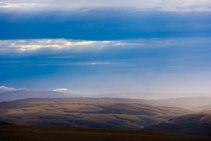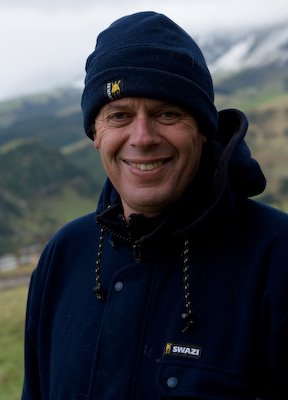
Many Photographers are concerned only with the subject and they seek to render it as it is. Often they fail to observe that the lighting and the atmosphere adorn and transform even the most humble and commonplace objects.
Leonard Misonne (1870-1943)
As a photographer you enlarge or emphasise certain moments, making it another reality. In the photograph you can scrutinise all kinds of details, you can see things you would normally not pay so much attention to.
Rineke Dijstra (1959-)
The weather was shuffling the cards. After days of warm Norwest winds, the whole district knew a change was on the way. Everybody was talking about it. The whole district was holding its breath. As so often happens here in
What was coming became obvious late on Thursday evening. The sky was sinking into a kind of grey mournful torpor. The wind had died away, and the light was taking on a grim sombre appearance. Down at the end of the valley the storm was gathering, sizing up its foe before it struck. Then, as day and night changed guard, the storm raced into town. I went to bed and lay there, listening to it plucking spitefully at the building.
By morning it was gone. A blue hole had opened above the district, and only the remnants of the previous night's ferocity prowled along the hills surrounding the basin. But there was more in store. We all knew that.
I couldn't help myself. I hadn't made a picture in a week and my 10-plus-a-day rule was well and truly broken. I needed to get out, to be along the land, to look at what had happened, what was going to happen. I packed the truck, so keen to get out that I didn't bother with breakfast. Somehow I wasn't hungry. The expectation more than filled me up.
The truck slithered and slurped her way along the yellow gravel roads out towards Wedderburn, occasionally waggling her behind coquettishly in the soft slushy surface and revelling in the fine yellow mud that quickly coated her flanks and wheel arches. I had driven this road often but always in the opposite direction. Now, in the early morning light, I saw it in a completely different way. I've noticed that. You can drive the same road for years and everything looks the same: drive it in the opposite direction and you get a completely new take on it. For that reason, when I'm exploring, I frequently check my rear vision mirrors; the perspective can often be quite surprising.
This particular leg took me out and a cross the flats at the head of the Valley. Instinct suggested I should take the narrow road to the telecommunications repeater on the top of Little Mount Ida. By the time I got up there, some 1500 feet above the valley, the Norwest wind was picking up. It was arm-wrestling the remains of the southerly storm and, from where I stood, I could look out across the entire valley and see almost out to Cromwell. It was breathtaking being this high and this close to the Hawkdun mountains The sun was doing its best to make a statement, but the high cirrus cloud held it in check. Nonetheless I managed to make a number of pictures before hunger and the soft light drove me back into town.
cross the flats at the head of the Valley. Instinct suggested I should take the narrow road to the telecommunications repeater on the top of Little Mount Ida. By the time I got up there, some 1500 feet above the valley, the Norwest wind was picking up. It was arm-wrestling the remains of the southerly storm and, from where I stood, I could look out across the entire valley and see almost out to Cromwell. It was breathtaking being this high and this close to the Hawkdun mountains The sun was doing its best to make a statement, but the high cirrus cloud held it in check. Nonetheless I managed to make a number of pictures before hunger and the soft light drove me back into town.
Although I had things to do, my weather eye was on standby. As I often do I walked down the end of the street and looked to the south. I knew something was coming. Then I saw it; a blue black presence along the bottom of the horizon, and drifting curtains of rain. Above me the hole in the sky was slowly but surely beginning to close. It was time to go out again. There was something new in the weather that I hadn't seen before, that I wanted to capture.
I headed west across the valley towards the  happening to the South. Cumulo-nimbus clouds were gathering above the Rock and
happening to the South. Cumulo-nimbus clouds were gathering above the Rock and
I worked my way south photographing as I went, until somewhere near Patearoa I ran into the front edge of the storm and the rain on my windscreen turned me back towards Ranfurly. As I came into town, I could see a wall of rain slowly but surely advancing like a line of infantry towards the town. I drove out the other side and climbed onto the hill above the golf course, where I could look back across the town and watch it come. The wind was already beginning to shake the truck as I got out. Above the town, a huge blue black cloud was shambling along like some mythical Oliphant, dragging curtains of rain behind it, a thing of vast and terrifying beauty, a beast of war. I watched it ain awe, then, at almost as an afterthought, reached for my camera. I managed about six exposures before the first heavy drops of rain began to strike me in the face.
As I retreated, the full force of the hailstorm threw itself at the town. Within minutes there was a layer of hail 2 cm thick blanketing everything.
It was 4 pm; time for lunch.




4 comments:
Now I know why a comment about the exhibition hanging wouldn't go through - you were busy posting this.
Magnificent skies, and I love the descriptions of chasing and capturing them.
Are you becoming a photographic Sutton-of-the- Maniototo?
Tony,
Yep, it sure was some hailstorm! I could hardly see the road to drive.
Great description you gave and great images too.
Dion
Dunedin
Hi Dion:
Sorry I missed you!
I'll give you a ring sometime so we can catch up. Away next Friday in ChCh for a wedding, but maybe after that.
Peregrina:
Sutton-of-the Maniototo?
Explain please. I am intrigued.
"Sutton-of-the-Maniototo. Explain please."
Yes, Sir! I'll try, Sir.
In a game of Association, William Sutton's name would always conjure up for me an image of vast expressive Canterbury skies over a narrow strip of land along the lower frame. Or maybe not necessarily all that narrow. But the sky is the dominant feature. You've posted a few like that since you moved to the Maniototo.
Of course, Sutton painted lots of other subjects, too, so maybe other people have a different association. Maybe I make that association because these were the first of Sutton's paintings that I became aware of. And, of course, it's not just in some of your Maniototo images that skies are so dominant.
A secondary link. He, too, was concerned about what was happening to the - in this case Canterbury - landscape. (I'm thinking here of what you say in your last sentence of "Artist's Statement" in the Exhibition blog.) He painted his Plantation series in protest at the proliferation of pine plantations on the hills. That wasn't in my mind when I made my remark, though. It was a thought that came later. The connection that prompted my remark was the Big Skies.
Post a Comment